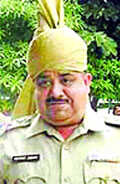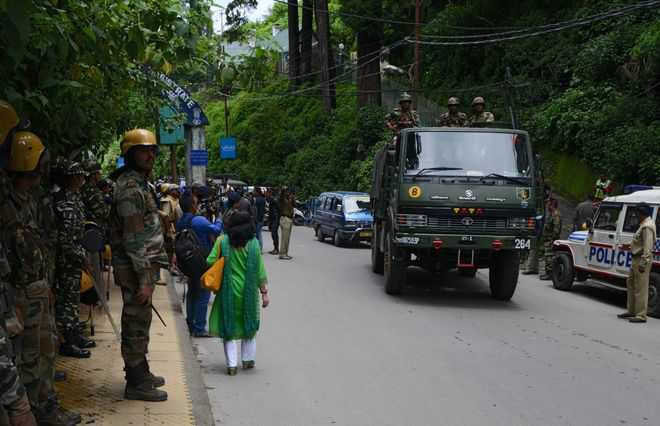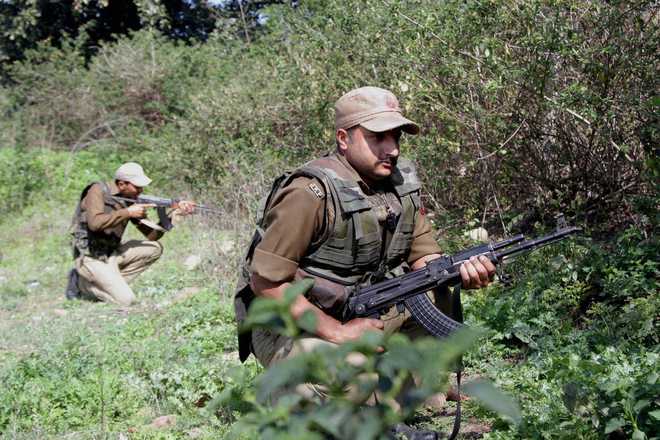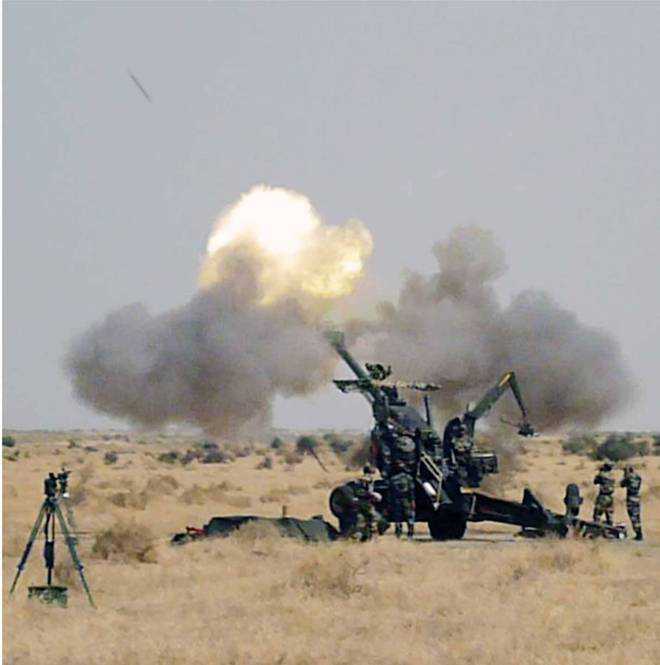 Yuva Rajput Sabha members pay tributes to Brig Rajinder Singh in Jammu on Wednesday. Tribune Photo: Inderjeet Singh
Yuva Rajput Sabha members pay tributes to Brig Rajinder Singh in Jammu on Wednesday. Tribune Photo: Inderjeet SinghTribune News Service
Jammu, June 14
Paying tributes to Brig Rajinder Singh on his 118th birth anniversary, Member of Legislative Council (MLC) Vikramaditya Singh said he was among the greatest Dogra warriors and his supreme sacrifice must never be forgotten.Recalling his past, Vikramaditya said after graduating from the Prince of Wales College, now the GGM Science College, Jammu, Brig Rajinder Singh had joined the State Forces as a Commissioned Officer. After having commanded 6 JAK Rifles, Kashmir Brigade, Brig Rajinder Singh was chosen by Maharaja Hari Singh to replace Maj Gen HS Scott as the Chief of Army Staff of the J&K State Forces on September 24, 1947.Paying tributes and homage to all men of the J&K State Forces who sacrificed their lives from the time of Maharaja Gulab Singh, the founder of the state, �Vikramaditya said, “we must never fail to remember brave Indian soldiers and the great martial traditions of the Dogras, as �history has failed to do justice to them.”Vikramaditya said his father, Dr Karan Singh, often recalled when, as a young man, he was present at the time when Maharaja Hari Singh called Brig Rajinder Singh and gave him orders to defend Srinagar from the advancing Pakistani forces till the last man and last bullet.The MLC added that from October 23 to 26, 1947, with only 100 men at his disposal, Brig Rajinder Singh held back over 5,000 invaders. He and his men laid down their lives. For this, Brig Rajinder Singh came to be known as the “Saviour of Kashmir” and was awarded the first Gallantry Award of independent India.
![[IMG]](https://defence.pk/pdf/proxy.php?image=http%3A%2F%2F1.bp.blogspot.com%2F-jMUCzIUatoc%2FTWDtUwqqOjI%2FAAAAAAAADoU%2FFVn-aCR1amk%2Fs640%2Frajindar.jpg&hash=2ce367bcbfc20ac0217d4e05f82e69c0)
Braveheart remembered
The Yuva Rajput Sabha celebrated the 118th birth anniversary of Brig Rajinder Singh in Jammu on Wednesday. Sabha president Rajveer Singh along with other members gathered at Brig Rajinder Singh Chowk and garlanded the statue. Speaking on the occasion, Rajveer said it was because of Brig Rajinder Singh’s supreme sacrifice that J&K was able to successfully crush the invaders from Pakistan in 1947. He said the braveheart, with only a handful of soldiers, defended the state capital and a large region from going into the enemy’s hands. Brig Rajinder Singh was also awarded the highest honour of Maha Vir Chakra.
Brig Rajinder Singh: The Saviour of Kashmir
Come October and we remember Brig Rajinder Singh, MVC, (Posthumous) the Saviour of Kashmir. He was born on 14th June 1899 at Village Baguna (now Rajinder Pura) and Commissioned on 14th June 1921. he became Brig in May 1942 and took over as Chief of Staff J and K State Forces from Maj Gen H L Scot on 24th Sep 1947 when the State was, in fact an Independent Country. When Pakistan attacked Kashmir on 22th Oct 1947 and Maharaja Hari Singh was informed about the fall of Mazaffrabad. He ordered Brig Rajinder Singh:-
‘Brig Rajinder Singh is commanded to hold the enemy at Uri at all costs and to the last man.’
Accordingly Brig Rajinder Singh proceeded towards Muzaffrabad with a small Force of Hundred men. After inflicting heavy casualties on the invaders numbering 6,000 at Garhi he decided to blow Uri bridge and delay the Pakistani forces to enable Maharaja Hari Singh to carry out Accession Parleys so that Indian Army could move in to ultimately save the State and throw the invaders out.
After demolishing Uri Bridge he fought delaying actions at Uri, Mahura and Rampur inflicting heavy casualties to gain four days till he was ambushed at Buniyar on the night of 26/27th Oct 1947 and fately wounded but not before achieving a miracle, as the Indian Army landed within six hours after his last action to save the State. Thus we see Brig Rajinder Singh achieving the impossible as ordered by his Ruler ‘To the Last Man’, literally being the last man setting an example for the World which remains unparalled. It was also in Oct 1947, i.e. 26th Oct when Maharaja Hari Singh acceded J and K to the Indian Union after Brig Rajinder Singh his Chief of Staff had saved Kashmir. Brig Rajinder Singh thus became the Saviour of Kashmir and was awarded the first Gallantry Award of Independent India posthumously.
Now the contribution of Brig Rajinder Singh to the making of the Modern India, Maharaja Gulab Singh had founded this unique State which included the most Strategic area of the World now called the Northern Areas which was acceded to India on 26 Oct 1947 through Accession made possible by Brig Rajinder Singh.
Maharaja Hari Singh has also contributed in making the present History. Firstly the Dogra rulers never allowed a foot hold to the British in spite of many attempts to take over the control of the State particularly during Maharaja Partap Singh’s times. Even during World War II when the Britishers wanted the control of the strategic Gilgit Maharaja Hari Singh gave the area of Gilgit only on lease for 40 years which was returned by the British Govt. of India just before Independence in Jul 1947 when Maharaja Hari Singh sent Brig Ghansara Singh as Governor of Gilgit who continued to be the Governor till 1st Nov 1947even after the invasion of Kashmir by Pakistan on 21st Oct 1947 where Brig Rajinder Singh the Chief of Staff of J and K State Forces delayed their advance for four days upto 26 Oct. On the day of Accession Gilgit was with us and was acceded to India. Again it was possible due to Brig Rajinder Singh’s action to Save Kashmir.
Only if the Indian Govt. had sent a company worth troops to Gilgit before 1st Nov 1947 Gilgit and Baltistan would have never been lost as Pakistan never conquered these areas. It was Maj Brown Commander of the Gilgit Scouts serving under the Governor of Gilgit who had revolted and arrested the Governor on 1st Nov and handed over the entire area of Baltistan to Pakistan without a fight. Thus Maharaja Hari Singh’s contribution by signing the Instrument of Accession legally and constitutionally acceding the entire State to the Indian Union is his unique contribution in making of the History which in fact is the only legal authority for India to hold on to the State or ultimately to retrieve the lost areas, may be in the 21st century itself as the events are unfurling. Who made it possible. It was Brig Rajinder Singh.
Today we pay tribute to the Saviour of the State, Brig Rajinder Singh, MVC (Posthumous), recipient of the Independent Nation’s first Gallantry Award for which the State is justifiably proud. It is worth recalling two tributes paid to him on his Birth Centenary Celebrated by the State from 14th Jun 1999 to 14th Jun 2000 immediately after the Kargil War. These tributes are quoted for the younger generation:-











![[IMG]](https://defence.pk/pdf/proxy.php?image=http%3A%2F%2F1.bp.blogspot.com%2F-jMUCzIUatoc%2FTWDtUwqqOjI%2FAAAAAAAADoU%2FFVn-aCR1amk%2Fs640%2Frajindar.jpg&hash=2ce367bcbfc20ac0217d4e05f82e69c0)

























































